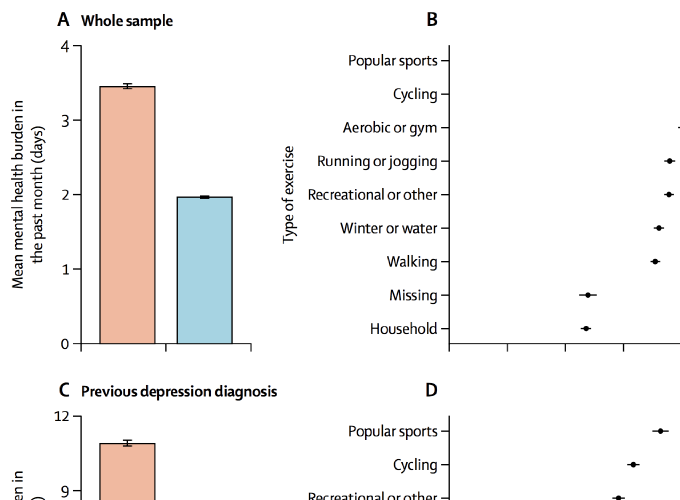Association between physical exercise and mental health in 1·2 million individuals in the USA between 2011 and 2015: a cross-sectional study

Association between physical exercise and mental health in 1·2 million individuals in the USA between 2011 and 2015: a cross-sectional study
Abstract
BACKGROUND: Exercise is known to be associated with reduced risk of all-cause mortality, cardiovascular disease, stroke, and diabetes, but its association with mental health remains unclear. We aimed to examine the association between exercise and mental health burden in a large sample, and to better understand the influence of exercise type, frequency, duration, and intensity.
METHODS: In this cross-sectional study, we analysed data from 1 237 194 people aged 18 years or older in the USA from the 2011, 2013, and 2015 Centers for Disease Control and Prevention Behavioral Risk Factors Surveillance System survey. We compared the number of days of bad self-reported mental health between individuals who exercised and those who did not, using an exact non-parametric matching procedure to balance the two groups in terms of age, race, gender, marital status, income, education level, body-mass index category, self-reported physical health, and previous diagnosis of depression. We examined the effects of exercise type, duration, frequency, and intensity using regression methods adjusted for potential confounders, and did multiple sensitivity analyses.
FINDINGS: Individuals who exercised had 1·49 (43·2%) fewer days of poor mental health in the past month than individuals who did not exercise but were otherwise matched for several physical and sociodemographic characteristics ( W =7·42 × 10 10 , p<2·2 × 10 −16 ). All exercise types were associated with a lower mental health burden (minimum reduction of 11·8% and maximum reduction of 22·3%) than not exercising (p<2·2 × 10 −16 for all exercise types). The largest associations were seen for popular team sports (22·3% lower), cycling (21·6% lower), and aerobic and gym activities (20·1% lower), as well as durations of 45 min and frequencies of three to five times per week.
INTERPRETATIONS: In a large US sample, physical exercise was significantly and meaningfully associated with self-reported mental health burden in the past month. More exercise was not always better. Differences as a function of exercise were large relative to other demographic variables such as education and income. Specific types, durations, and frequencies of exercise might be more effective clinical targets than others for reducing mental health burden, and merit interventional study.
More detail can easily be written here using Markdown and $\rm \LaTeX$ math code.